2 Chapter 2 – The diverse field of instructional design
The requirements of learning designers and how instructional design is operationalized in various industries
Bowman, M., Ely, J., North, C. & Shortt, M.
Introduction
Instructional design (ID) is an interdisciplinary profession where many designers come from a variety of academic and professional backgrounds. Instructional designers often are instrumental in workplace learning and higher education. While the job title and duties may vary from organization to organization, typically instructional designers create learning experiences for students, faculty, and staff based on organizational needs. These learning experiences can be created for face-to-face, blended, or online learning environments. Instructional designers are often expected to be experts in curriculum development, learning theories, and learning technologies. Due to the diversity of backgrounds of designers, it can be challenging for instructional designers to have a baseline knowledge of instructional design (Brown & Green, 2015). Furthermore, the standard of instructional design and what is and is not acceptable often varies depending on the organization that employs the instructional designer. Working in a profession that has been revolutionized by technology by delivering eLearning and virtual instruction, it is often difficult for instructional designers to keep up with the rapid pace of technology (Reiser, 2017). Furthermore, with many instructional designers not having a formal professional development budget, often they are on their own to develop new skills and upskilling themselves (Cheong, Wettasinghe, & Murphy, 2006). This chapter will explore how instructional design is operationalized in job postings.
What is instructional design?
The following video provides a brief overview explaining the purpose of instructional design.
What is Instructional Design? by Prometheus Training
Common Instructional Design Principles
The following video provides an interview with the Artisan Talent agency, an interactive, digital, marketing and creative staffing agency.
Common Instructional Design Principles by Artisan Talent
While many fields have employees in instructional design roles, those roles differ in specific job responsibilities As such, we asked the following research questions.
Research Questions
-
What can we learn about the requirements of instructional designers from current global job descriptions?
-
How is instructional design operationalized in the lens of various industries?
For anyone thinking about a first career or seeking a new career, and for those who currently or wish to collaborate with instructional designers, this chapter will explain different fields within the instructional design domain, other titles given to instructional designers, the personal and educational characteristics required, and the job responsibilities of the people within those roles.
Fields of Instructional Design
In this section, we described the roles of IDs in specified fields, based on job postings. Within each section, we analyzed the text and find common themes. Specifically, we discussed qualifications needed to be hired (skills and education) and job requirements once hired. This section is divided into four sub-sections: Training, Higher Education, K-12, and Educational Corporations. We used the Association for Talent and Development’s (ATD) training and development competency model, which is outlined in great detail in Figure 1.1 below, to analyze job postings. We also took a look at ID job postings internationally and reflected on our research limitations.
Training
According to the Occupational Outlook Handbook, the job outlook for learning and development specialists will grow by 11% from 2016-2026 – Click HERE to view source (US Bureau of Labor Statistics, 2018). With training being a constant scapegoat to corporate disasters and poor behavior, it is clear that instructional designers are high in demand for many reasons. Many companies turn to training programs for legal defensibility in some situations and others use it as a punitive option for bad behavior on the job. Regardless of the reason, there are many job openings in corporate learning and development that require a vast array of skills.
To organize this analysis of corporate job postings, we used the Association for Talent and Development’s (ATD) training and development competency model and its components to classify each job posting. The Association for Talent and Development is a professional development organization for learning and development professionals. In addition to the national chapter and local chapters, the organization also has a credentialing body where learning and development professionals can become a Certified Professional in Learning Performance (CPLP). The knowledge test for the CPLP is made up of questions from each area of the ATD Competency Model Figure 1.1. Each portion of the competency model has substates that explain more about the piece of the model. The pieces of the model are performance improvement, change management, knowledge management, coaching, integrated talent management, managing learning programs, evaluating learning impact, learning technologies, training delivery, and instructional design. The foundational competencies of the model will also be explored but were not a driving force of this analysis.
Figure 2.1: ATD Competency Model for Learning and Development
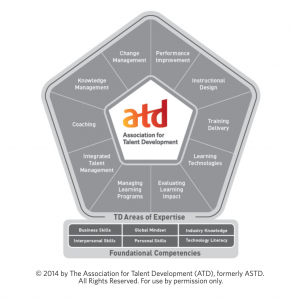
Analysis of the job postings:
In order to compare and analyze corporate learning and development jobs, we set criteria for inclusion and exclusion for the analysis. Here are the main inclusion criteria:
Inclusion criteria:
- Must be a full-time job
- Must use the term “instructional design” somewhere within the job advertisement
- Must be located in the United State or eligible for remote work in the United States
- Must list at least 5 job duties
- Must have preferred and required qualifications
To begin this research, we searched on Indeed.com and used the full-time job and United States filter and used the term “instructional designer”. Indeed.com was chosen throughout this chapter because its ease-of-use search engine and initial number of related jobs. Furthermore, Indeed.com is an aggregator, meaning it searches jobs across many sites. By doing this it removed about 339 jobs from the first search using “instructional designer”. This yielded 2,068 total jobs and of these jobs, we included the first 25 job postings that used these five criteria. We then copied the text of each job description into a word processing document to easily use the seek function to find commonalities. We compared the job postings to the ATD Competency model to see how much of the model can be found in the selected sample and which competencies were dominant in the postings.
Performance Improvement
According to the ATD Competency Model, performance improvement is defined as being able to “apply a systematic process for analyzing human performance gaps and for closing them.” This is a critical function of many learning and development jobs and also a key component for sharing information to management about behavior change. An example of a performance improvement campaign would be a learning experience focused on a population creating more widgets to raise the outputs at a factory. For this category, the key terms searched throughout the job postings included “gap analysis” and “human performance models.”
By doing so, 14 of the 25 job postings mentioned the need for an instructional designer to have a level of understanding of this competency. A common way this was displayed on a job posting was by using the term “performance support.” One job posting described it “… staff development to enhance the effectiveness of employee performance in achieving the goals and objectives of the company.” This function was present in associate, mid-level, and senior instructional design roles as well as management.
Change Management
Change management was further defined by the ATD Competency Model by “applying a systematic process to shift individuals, teams, and organizations from current state to the desired state.” In other words, how does the instructional designer facilitate planning for change and support the intervention? On the job, this can look like a learning campaign focused on a new policy from a company acquisition becoming a core value of the current company. To analyze job postings for components of change management, the key term searched throughout was “change.”
Nine of the 25 selected job postings mentioned the need for an instructional designer to have a level of understanding of this competency. One job posting made it clear that the organization’s culture valued change and embraced it. Another job posting shared that change was important for their learning strategy that the instructional designer must create a change management plan to help evaluate the maintenance and lifecycle of learning campaigns.
Knowledge Management
Knowledge Management is defined by ATD as “the capture, distribute, and archive intellectual capital to encourage knowledge-sharing and collaboration.” Other components of knowledge management include benchmarking knowledge management best practices and lessons learned, supporting the development of a knowledge management infrastructure, and transforming knowledge into learning. Based on this definition, an example of this includes creating templates for subject-matter experts to share institutional knowledge to create a learning campaign. To analyze job posting for components of knowledge management, we searched for key terms throughout including “knowledge” and “transfer.”
Surprisingly, only 9 of the 25 selected job positions mentioned the need for an instructional designer to have a level of understanding of this competency. Ways this showed up in the job postings included “transferring knowledge into learning” as an essential job function and “creating a culture of learning.”
Coaching
According to the ATD Competency model, a learning and development professional uses coaching by “applying a systematic process to improve others’ ability to set goals, take action, and maximize strengths.” Some components of coaching include managing progress and accountability, displaying a coaching presence, and asking powerful questions. The coaching function for instructional designers can vary from organization to organization, however, coaching skills can be leveraged when working with subject matter experts. For example, as an instructional designer, you will work with at least one difficult subject matter expert throughout your career. This subject matter expert may be difficult for a number of reasons but often it is because they do not want to share institutional data with you for fear of losing their job. An instructional designer well versed in coaching can help the subject matter expert understand the project better and leverage their knowledge as a strength to help others improve throughout the organization. To analyze job posting for components of coaching, we searched for the key term throughout “coaching.”
Perhaps the most shocking of all the searches, only 1 of the 25 job postings mentioned the need for instructional designers to have a level of understanding of this competency. The job posting it was present in listed coaching as a preferred qualification and specifically sought “5+ years demonstrated experience providing coaching and/or feedback to participants, teammates, or associates a plus.”
Integrated Talent Management
Integrated talent management is defined by ATD as the ability to “build an organization’s culture, capability, capacity, and engagement through people development strategies.” Some of the essential functions of this competency include coordinating workforce and succession planning, supporting engagement and retention efforts, and aligning talent management to organizational objectives. An example of how an instructional designer would work within the integrated talent management competency is to create career pathways through training at an organization. For example, if a widget maker would like to become a senior widget maker, using skills in the integrated talent management would enable an instructional designer to develop curriculum and learning experiences to help upskill someone to the next level. To analyze job posting for components for talent management, we searched using the key term “talent.”
Three of the 25 job postings mentioned the need for instructional designers to have a level of understanding of this competency.
Managing Learning Programs
The way that managing learning programs are defined by the ATD is to “provide leadership to execute the organization’s people strategy; implements training projects and activities.” Some components of this competency include to ensure compliance with legal, ethical, and regulatory requirements, manage and implement projects, and develop and monitor the budget. To analyze job postings for components of managing learning programs, we searched for key terms throughout including “budget” and “manage.”
Twelve of the 25 job postings mentioned the need for instructional designers to have a level of understanding of this competency. For this competency, most of twelve postings (10) had managing learning programs as a preferred qualification.
Evaluating learning impact
Evaluating learning impact is defined by ATD as the ability to “use learning metrics and analytics to measure the impact of learning solutions.” Some ways instructional designers evaluate learning impact includes selecting appropriate strategies, research design, and measures. To analyze job postings for components of evaluating learning impact, we searched for key terms throughout including “evaluation” and “data” and “analytics.”
Like managing learning programs, twelve of the 25 job postings mentioned the need for instructional designers to have a level of understanding of this competency. Once again, ten of the job postings listed this as a preferred qualification.
Learning Technologies
“Applying a variety of learning technologies to address specific learning needs” is the way that ATD defines learning technologies. In practice, this can include the ability to use technology effectively across the different areas of expertise and identify when and how to use technology as a training and development solution. To analyze job postings for components of learning technologies, we searched for key terms throughout including “technology” and “LMS” and “tool.”
Fourteen of the 25 mentioned the need for instructional designers to have a level of understanding of this competency. Many of the fourteen named specific software packages such as Articulate Storyline, Adobe Captivate, and various names of Learning Management Systems.
Training Delivery
The term training delivery can make one think of a face to face training however this is not always the case. Training delivery is defined by ATD as the ability to “deliver informal and formal learning solutions in a manner that is both engaging and effective.” Some specific ways instructional designers perform training delivering can include aligning learning solutions with course objectives and learner needs and build learner motivation. To analyze job postings for components of training delivery, we searched for key terms throughout including “facilitation” and “ delivery.”
Six of the 25 mentioned the need for instructional designers to have a level of understanding of this competency. A reason for this could be because, in many of the job postings, the work focused on an instructional designer creating digital artifacts. Interestingly, none of the selected job postings mentioned anything about facilitation in an online environment despite many organizations have virtual classroom training.
Instructional Design
Instructional design is defined by ATD by the “design and develop informal and formal learning solutions using a variety of methods.” What does that mean in practice? Some examples include identifying appropriate learning approach, designing a curriculum, program, or learning solution, and developing instructional materials. To analyze job postings for components of instructional design, we searched for key terms throughout including “instructional design” and “ADDIE.”
All 25 of the selected posts did mention instructional design within the job posting and 7 specifically mentioned ADDIE.
Higher Education
In institutions of higher education, instructional designers are often employed to aid instructors in designing their courses, whether they are face-to-face courses or online courses, each of which use learning management systems (LMS), or a blended format. In some universities, IDs are assigned to specific colleges or departments (College of Business, for example), while other universities might move IDs to different courses as needed. To understand the roles and responsibilities of instructional designers within the field of higher education, a search of job postings was conducted.
Analysis of the job postings:
Similar to the job search in the training field, we set criteria for inclusion and exclusion in order to compare and analyze design and development jobs in higher education:
Here are the main inclusion criteria:
Inclusion criteria:
- Must be a full-time job
- Must use the term “instructional design” somewhere within the job advertisement
- Must be located in the United State or eligible for remote work in the United States
- Must be in a post-secondary institution, either online or brick-and-mortar; can be community college, four-year, or advanced degree institution
Search Terms:
To begin, we searched on HigherEdJobs.com, using the full-time job and United States filters, and the term “instructional designer.” We chose HigherEdJobs.com over Indeed.com because of a higher chance for locating relevant jobs. This yielded 1,113 total jobs, many of which were “instructor” positions, and not within the desired field. We then check marked the “Instructional Technology” category within the site. This narrowed it down to 199 job postings. Of these jobs, we included the first 10 job postings that used these four criteria. We then copied the text of each job description into a word processing document to easily use the seek function to find commonalities. We compared the job postings to the ATD Competency model to determine which competencies appeared.
Within the search, a number of job titles were found, similar, yet different.
Job Titles:
- Instructional Designer
- Instructional Design Specialist
- Instructional Technologist
- Coordinator of Instructional Design (a more senior position)
- Instructional Design & Technology Specialist
- Technology Specialist/Online Training Developer
- Digital Learning Designer
- Instructional Designer & Technologist
Job Responsibilities:
As was done in the previous Training section, the job postings were analyzed to determine which competencies were included in the postings.
Evaluating Learning Impact: Using the search terms “evaluation,” “data,” and “analytics,” six of the 10 postings involved this competency.
Learning Technologies: To analyze job postings for components of learning technologies, we searched for key terms throughout including “technology” and “LMS” and “tool.” All 10 of the postings mentioned and described responsibilities within this competency.
Instructional Design: To analyze job postings for components of instructional design, we searched for key terms throughout including “instructional design” and “ADDIE.” All 10 of the selected posts did mention instructional design within the job posting and 1 specifically mentioned ADDIE.
The following competencies did not specifically appear in any of the postings:
- Performance Improvement
- Change Management
- Knowledge Management
- Coaching
- Integrated Talent Management
- Managing Learning Programs
- Training Delivery
It is possible that the postings used different language, as mentioned in the limitations section below; however, none of the above were outwardly detected.
Knowledge, Skills, and Abilities:
All job postings require a minimum of a Bachelor’s degree, many require or prefer a Master’s degree. Most state the degree should be in Instructional Design, Instructional Technology, Education, or a related field. One posting also includes Game Design in the list. Some do not provide a field, only that a degree is required.
K-12 Education
Instructional Design (ID) within the context of K12 education is an emerging sector. As a result, defining ID jobs in K12 education is ill-structured and complex and ID-related jobs that do exist are limited in number. In many school’s today, teachers are often expected to be the “instructional designer,” “subject-matter expert,” “IT specialist,” “project manager,” and “graphic designer” all rolled into one. Increased emphasis on evidence-based practices and data analytics to measure student growth and achievement have created a need for instructional supports for teachers and administration. Facilitating effective implementation of curriculum and professional learning is at the core of K12 instructional design.
Delineating differences in the roles of teachers and instructional designers (IDs) is not a clear-cut task due to a variety of creative job titles. While there is no singular job title to encompass the role of ID in K12 education, there are several positions which contain overlapping attributes, but also maintain unique qualities to each role. Using a series of web-searches through job sites, it became evident that ID jobs in K12 can be qualified in four sub-groups: Instructional Designers, Instructional Coordinators, Instructional Coaches, and Instructional Technology Specialists. The U.S. Bureau of Labor Statistics (2018) categorizes these jobs under the umbrella of “Instructional Coordinators (Curriculum Specialists)” : defined as individuals who ”develop instructional material, coordinate educational content, and incorporate current technology in specialized fields that provide guidelines to educators and instructors for developing curricula and conducting courses. It includes educational consultants and specialists, and instructional material directors” (“Occupational Employment Statistics: Instructional Coordinators”, 2018). Projected job outlook numbers anticipate an 11% growth rate which is faster than the national average (US Bureau of Labor Statistics, 2018).
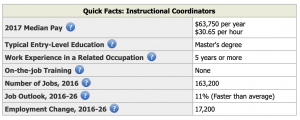

Search Terms:
Initial web-searches for the terms “K12 education” AND “Instructional Designer” yielded a range of results including graduate programs for ID, job postings for IDs in corporate settings, and blogs for “How to become an ID”. More targeted searches were then used for job titles and postings through K12jobspot.com, schoolspring.com, linkedin.com/jobs, and indeed.com. The majority of targeted searches focused on K12jobspot.com and schoolspring.com because these are two of the top sites for educational job postings in the K12 sector in the U.S. Additionally, linkedin.com/jobs, and indeed.com were the only general job sites that produced ID job postings in K12 education that fit search parameters. Focusing on national job posting websites tailored to K12 schools allowed for gauging the job market while also defining ID roles for K12 education and within K12 education.
Instructional Designer (click to view PDF Job Postings in box.com)
Job Titles: Instructional Designer, Curriculum Designer
Positions for instructional designers in connection with K12 education are typically employed through educational companies that are developing online curriculum and blended learning content for K12 schools. While all positions analyzed are full-time employment, some are offered as contract positions for a limited duration.
“The Role for Instructional Designers in Developing the K12 Educational Environment”- Ed Week, October 2012.
Job Responsibilities:
Instructional Designers in K12 are involved with partners and stakeholders internally and externally to develop digital learning experiences. Some examples include, working with textbook publishers to “convert their curricula into digital learning experiences” or clients who “want to differentiate through online and blended learning via our platform”(“Instructional Designer K12-MassiveU”, 2019). Instructional Designers assess and identify course needs through work with subject matter experts (SMEs) and network with other sectors such as graphic designers and contractors for video production. They may also function as project lead and are responsible for maintaining and revising course content. Instructional Designers mentor ID staff and teachers through reviewing, critiquing, and facilitating discussion of instructional design techniques, lessons, and/or digital learning assets.
Knowledge, Skills and Abilities:
Instructional Designers for K12 must have a knowledge and understanding of curriculum alignment in K12 schools and professional learning following state and national standards. Expertise in learning theory and online pedagogy are also crucial. For example, IDs will apply this knowledge to “transform online learning, through project based, social learning platforms” (“Instructional Designer K12-MassiveU”, 2019). Knowledge of student engagement frameworks and 21st Century Skills are also relevant in course design for K12 schools. Job postings also emphasized the need for a balanced individual; merging creativity and analytical thinking skills to meet project requirements and deadlines to high standards through self-motivation and independence. Communication and interpersonal skills are also highly emphasized along with technology skills and team management.
Experience:
Instructional Designers in K12 education require 3+ years of relevant professional experience including areas such as teaching, online learning, or learning science. Former K12 teaching experience is preferred in all postings. Also, a minimum requirement of a Bachelor’s in Instructional Design or a related field was specified in addition to a “record of past achievement developing engaging and effective online learning content” (“Instructional Designer K12-MassiveU”, 2019).
Instructional Coordinator (click to view PDF Job Postings in box.com)
Job Titles: Instructional Coordinator, Curriculum Specialist, Coordinator of Digital Learning, Instructional Technology Coordinator
Positions for Instructional Coordinators in connection with K12 education are typically employed by K12 School districts, charter schools, or Educational Service Centers (ESCs). All positions analyzed are full-time employment and require working in an office setting and traveling to schools.
“Instructional Coordinators Career Video”- CareerOneStop, May 2018.
Job Responsibilities:
The primary responsibility of Instructional Coordinator is facilitating, coordinating, and/or leading the development of digital learning. In addition to leading the design phase, postings require Instructional Coordinators to implement digital learning projects and actively support teachers. The creation of high quality, rigorous content and relevant best practice instruction through technology was reiterated in criteria such as meeting the “expectations of high stakes testing and accountability systems, while simultaneously creating the conditions within today’s classrooms for personalization, developing 21st Century skills, teaming, learning how to learn, taking responsibility for one’s own learning, and possessing the ability to innovate” (“Coordinator of Digital Learning #1410270”, 2019). Facilitation of purchasing new technologies and online resources and collaboration with departments of Curriculum and Instruction and administration were also listed responsibilities. This includes assessing current programs, technologies, and curriculum and integrating state and national standard requirements. Instructional Coordinators were generally traveling positions, splitting time between a central office and other locations throughout the district.
Knowledge, Skills, and Abilities:
Specific qualities of interpersonal skills, communication skills (written and verbal), leadership skills, decision-making skills, analytical skills and technology skills were listed in all Instructional Coordinator postings. Instructional Coordinators must be able to analyze data and evaluate teaching strategies in order to recommend changes to curriculum and instruction. They must be able to communicate their recommendations to educators and administrators at all levels. A broad knowledge of state and national education standards and understanding of technology standards (ISTE) were listed as well. Some postings highlighted the ability to be self-motivated and self-teach while multi-taking on a variety of tasks.
Experience:
Instructional Coordinator positions require a minimum of a Bachelor’s degree with Master’s preferred (in some cases required), in addition to a state teaching license. Previous experience was not always quantified, but rather postings listed a “proven track record of integrating technology in a classroom setting” or “experience managing large scale digital learning projects” (“Instructional Technology Coordinator”, 2019; “Coordinator of Digital Learning #1410270”, 2019). Work experience with a range of hardware, software, operating systems (Windows, Mac, iOS, Android) and mobile devices (Chromebooks, iPads, smartphones) in educational settings was specified. Prior experience mentoring and leading professional development with teachers or adult learners was also a common theme.
Instructional Coach (click to view PDF Job Postings in box.com)
Job Titles: Instructional Coach, Curriculum Coach, Technology Integration Coach, Instructional Technology Resource Teacher (ITRT)
Instructional Coaches are employed both at the building and district level in K-12 schools. While the positions analyzed are full-time, many require working with staff in multiple buildings and typically are filled by classroom teachers transitioning into coaching roles. Additionally, some districts employ classroom teachers as instructional coaches through supplemental positions.
“Les Foltos – Peer Coaching — 21st Century Teacher Skills”- TEDxManitoba, March 2011.
In this TED talk, Les Foltos, Director of Educational Innovation at Peer-Ed, an educational training company, explains the role of Instructional Coaching with educators in the K12 environment.
Job Responsibilities:
Instructional and Technology Coaches collaboratively work with teachers, administrators and staff at all levels to provide instructional and curricular supports and assist with technology integration through professional development and training sessions. In addition to designing and developing curricular and behavioral support materials for teachers, Coaches are responsible for analyzing data to evaluate curriculum and instructional programs. The ISTE Standards for Coaches serve as an industry standard for these positions, though many districts define these positions based on areas of need. States such as Virginia, have further specified the role of coaches through their Instructional Technology Resource Teacher (ITRT) positions. The Virginia Department of Education specifies ITRTs supporting role for educators according to research-based models of best practice and has released the ITRT Guidebook for the state of Virginia, recommending specific job tasks and responsibilities.
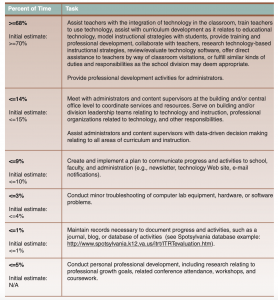
Knowledge, Skills, and Abilities:
Communication skills (verbal and written), interpersonal skills, and technology skills are integral qualifications for a position as an Instructional/ Technology Coach. Coaches must have a deep understanding of adult learning principles as well. While a background in instructional design and learning theory is ideal, many instructional coaches build their knowledge through prior teaching experience and on the job research.
Experience:
Coaching positions require a minimum of 3-5 years of teaching experience, a Bachelor’s Degree with Master’s preferred, and a state teaching license. Some content specific coaches may be required to have a degree in their content area as well. Mentoring and leadership experience are also crucial as coaching roles involve developing and leading professional learning, advising and observing teachers instructional process, and assisting with technology integration.
Instructional Technology Specialist (click to view PDF Job Postings in box.com)
Job Titles: Instructional Technology Specialist, Instructional Technologist
Job Responsibilities:
Instructional Technology Specialists provide support to teachers and administrators supplementing instructional programs with specific responsibilities for maintaining overall operations of school technology. This includes supporting teachers in the development of blended learning activities, navigation of the school’s learning management system (LMS), and digital resources. Additionally, Instructional Technology Specialists assist with administering performance tests for student assessment and competency levels and support developing tech-based individual learning plans. Device maintenance and technical support, aligned with district technology goals are central as well.
Knowledge, Skills, and Abilities:
Communication, organization, and presentation skills are crucial to success as an Instructional Technology Specialist. Classroom integration and involvement requires pedagogical, technological, and content knowledge in order to support and assist teachers. Technology maintenance and support are key in this role and require knowledge of a range of hardware and software, operating systems, devices and digital platforms.
Experience:
Instructional Technology Specialists in K12 settings require a Bachelor’s degree with Master’s preferred. Additionally most require 3-5 years of teaching experience and a valid state teaching license.
Educational Corporations
Educational publishing is a unique business in terms of the role an instructional designer plays in creating the products. Companies such as McGraw-Hill, Pearson, and Houghton-Mifflin Harcourt design, write, and publish both print and digital learning materials for K-12 and Higher Education students and teachers around the world. These companies often employ subject-matter experts (SME) who write the content (the first step in the process), and then these SMEs collaborate with instructional designers, graphic designers, media coordinators, and others to produce a final product that can be sold to schools and universities. In this field, the skills and responsibilities of an instructional designer are somewhat fluid, with people in other roles absorbing some of the tasks that might generally be thought of as instructional design tasks. For example, McGraw-Hill Education has Academic Designers, who are subject-matter experts first, but have taken on some of the instructional design tasks as they write, design, edit, and produce their curriculum.
Search Terms:
To determine the job requirements of an instructional designer in this field, a systematic search was conducted. First, a search was conducted on the career pages of educational publishers McGraw-Hill Education, Pearson, Houghton-Mifflin Harcourt, Discovery Education, Cengage, Scholastic, Curriculum Associates, and Zaner-Bloser. We chose these websites based on relevance to educational corporations/publishing. Searches were conducted using the terms “instructional designer” and then “designer.” After reading the titles and job descriptions, five job postings were determined to be related to the role of an instructional designer. This was followed by a job search on Indeed.com using keywords “instructional designer” AND “educational publishing.” We used Indeed.com in this case based on its aforementioned ease-of-use and to collect more jobs to analyse. While this resulted in many job postings, most were not within educational publishing. One job posting was determined to be related to both instructional design, and within the field of educational publishing. The six job postings most closely associated with the role of an instructional designer in the field of educational publishing are discussed in the following sections.
Titles (click to view PDF Job Postings in box.com)
Within this field, there are several titles for what might be considered an instructional designer (or someone performing instructional design tasks.) Pearson has Instructional Designers, (including Senior and Lead ID) (Pearson, 2019) as well as Learning Designers (Pearson, #1901334, 2019), which seem to have some of the same education, experience, and skills requirements. Cengage also has a Learning Designer role (Cengage, 2019), which does not appear to specifically be an instructional design job, but has some of the same skill requirements and lists an instructional design background as highly preferred. McGraw-Hill Education has Instructional Designers (although there are no current job postings) as well as Digital Interactive Designers (#39683, 2019), which also appear to have similar requirements. Similarly, Curriculum Associates has an Interactive Designer role (Curriculum Associates, 2019). Lexia Learning (a Rosetta Stone company) has eLearning Specialists (indeed.com, 2019), which also requires skills related to instructional design.
Qualifications and Responsibilities:
Using the ATD Competency Model (2014), these six job postings contain qualifications and responsibilities that align with some of the Foundational Competencies and Areas of Expertise. Under the Interpersonal Skills category, all job postings require good communication skills. Within Technology Literacy, all jobs require awareness of technologies (especially new and emerging), and the ability to use technology effectively. Under the Instructional Design area of expertise, these jobs require the candidate to identify and apply appropriate learning approaches and theories, to collaborate with others to design a learning solution, and to select technologies.
Some categories of the ATD Model are not included in these job postings. For example, in this field, it is not the role of the instructional designer to also be the project manager or coordinator (although project management skills like defining and meeting deadlines are useful).
After reviewing the job postings listed in the previous section, the knowledge, skills, and abilities required for these roles within educational publishing can be generalized. All of these jobs require a Bachelor’s degree. The ability to apply learning science and e-learning methodologies (instructional design principles) is important, along with strong written and oral communication skills. Knowledge of new technologies is a must.
The experience requirements are working with digital content and designing learning and a background in instructional design or curriculum development. A background in education is helpful as well.
The job or role requirements are evaluating current courses and tools to determine possible improvements, strategizing and designing learning experiences alongside content developers, managing production of courses, and ensuring the digital content meets industry standards. Some project management might be required.
The Role of Instructional Designers Internationally

Now that we have described the role of instructional designers in the USA, it is important to note the differences in countries other than the USA to gain insight of developments/requirements abroad. In this section, we will explore the roles of Instructional Designers in the following countries: Singapore, Australia, Japan, China, and the UK. Specific information gained from job postings will be combined into one section to present a broader idea of what Designers need in their respective countries.
A file with all job information can be found HERE (Click to view Microsoft Word file in box.com. Use Control+F to search for a specific country in the Word file.)
Search Terms:
Like above, a systematic approach was taken to search for jobs in the aforementioned target countries. Each search began on Google with “Instructional Designer jobs in (target country).” Unlike in previous sections, however, the search criteria needed to be specific:
Here are the main inclusion criteria:
Inclusion criteria:
- Must be full-time job.
- Must specifically be a job for ID and have “instructional designer” in the job title.
- The job posting must be in English and have more than 5 lines of information about the job.
- The job must be in the target country.
Not many ID jobs were revealed, even when searching on specific websites and job aggregators like Glassdoor, Indeed, or LinkedIn. Due to this, each job posting was reviewed for relevance. Singapore, Australia, and the UK were chosen as target countries because they have English as one of their national languages, which could make the job search easier. Japan and China were chosen because of personal interest. All map photos below are from goway.com/media/uploads/maps/. All other photos in this section are open source.
Jobs by Country:
i. Singapore:
Total number of jobs sampled: 2
Responsibilities:
- Instructional Design – Develop curriculum
- Coaching – Collaborate with teams
- Learning Technology – develop content with media assets (games, videos, etc.), support e-learning, mobile learning, and blended learning,
- Evaluating Impact – Monitor and respond to feedback
- Training Delivery – Conduct needs analysis, perform course testing/training
Industry fields: Engineering and Software security
Education requirements: Degree or MSc in Education, Psychology, Learning Sciences, ID, Instructional Tech, Training and Development, or Computer Engineering
Work Experience: At least 3 years of relevant work experience
Other specific requirements: Possess Advanced Certificate of Training and Assessment (ACTA) and/or Diploma in Adult and Continuing Education (DACE).
One job is for “Singaporeans-only.”

Although these Singaporeans ID jobs each required a Master’s, the jobs were open to a range of educational degrees. Since each posting detailed diplomas, degrees, or an MSc, the target seemed to be British. This was debunked, however, with the discovery of another posting that said “Singaporeans-only.” The posting became even more Singapore-specific after researching DACE, which is a Singapore-only diploma. Neither post mentioned frameworks like ADDIE. Even as the responsibilities and competencies mirrored USA jobs described above, such as conducting e-learning needs analyses and having project management skills, the jobs were clearly advertised with Singapore locals in mind.
ii. Australia:
Total number of jobs sampled: 5
Responsibilities:
- Instructional Design – Develop and deliver digital/online learning, e-learning, and blended content, Develop assessments, Craft engaging activities, Work across multiple ID projects, Apply project management skills
- Evaluating Impact – Audit current delivery methods, Develop monitoring systems to track employee progress
- Training Delivery – Conduct Needs Analyses, Determine mandatory learning requirements for new employees
- Coaching – Work with R&D teams
Industry fields: Federal University (Technical and further education), Flight Center Traveling, Foodservice, Recruitment Agency, and Risk Management
Education requirements: Certificate IV in Assessment and Training and/or Adult education.
Work Experience: 3-5+ years of relevant post qualification experience – Jobs prefer previous work as an L&D officer and Instructional Designer in a government or corporate context.
Other specific requirements: A Technical and Adult Education (TAE) qualification. Strongly encourages Aboriginals and Torres Strait Islanders to apply. Knowledge of software like Articulate, Camtsdis, and Adobe Captivate. Knowledge of ID and ADDIE design frameworks. The ability to travel, such as to/from various locations around Queensland.

Australia had the most relevant jobs online, and thus 5 were sampled instead of 2. The educational qualifications are Australia-specific – A Certificate IV is an Australia-specific qualification denoting specialized knowledge of skilled work. A Certificate IV is not a diploma, or even an Associate’s degree. It is a trade certificate for advanced skills. More information about the Certificate system can be found HERE. In line with ATD, one job mentioned ADDIE and another foundational business skills, but each emphasized needs analysis, project management, and software familiarity.
iii. Japan:
Total number of jobs sampled: 2
Responsibilities:
- Instructional Design – Designing content, Creating handbooks, storyboards, modules, and assessments
- Coaching – Collaborate with peers, Working with Leadership
- Learning Technology – Develop e-learning/mobile course software
- Evaluating Impact – Using client data to drive improvement
Industry fields: Customer Service and Software
Education requirements: Bachelor’s in relevant field like ID, Instructional Technology, or Communications. Master’s preferred.
Work Experience: 3 years of project management. 3-7+ years of ID experience. 5+ years with rapid e-learning development tools. 5+ years of using Microsoft Office tools.
Other specific requirements: Native Japanese language skills and business level English. Be familiar with the ADDIE model. Be familiar with software like Captivate and Storyline.

For those with prior experience working in Japan, a job-seeker reading the educational requirement “Master’s preferred” should instead read that as “Master’s required.” Even if the job-seeker comes equipped with the numerous years of experience requested by both jobs sampled, a Master’s will be a requirement to be competitive. Again, for those who have job-hunted in Japan before, the large amount of work experience required is intentional – Most jobs in Japan are filled internally by current employees moving up. Japanese companies post high-requirement jobs to outsiders in the off-chance that they can attract an outstanding employee. Business level English is required, presumably to conduct business with a global mindset according to the ATD competency model. E-learning and ADDIE familiarity are necessary, in addition to supervisory (i.e. project management) skills.
iv. China:
Total number of jobs sampled: 2
Responsibilities:
- Instructional Design – Technical Writing, Developing deliverables, Graphic Design, Design assessments/quizzes
- Coaching – Work in a team and independently
- Training Delivery – Conduct Needs analyses, Create holistic solution material
Industry fields: Human Resources and Consulting
Education requirements: Bachelor’s – Master’s preferred
Work Experience: 5-8 years with a Bachelor’s; 3-6 years with a Master’s; 0-3 years with a PhD
Other skills required: Excellent English language skills. Proficiency with Microsoft Office, Adobe Captivate, Articulate Storyline, and Camtasia. Chartered Institute of Personnel Development (CIPD) or other training related qualification (for one HR-related ID job).

China is the first country to have displayed an incremental experience requirement based on education. It is interesting to note that the jobs specifically stated that English language skills are required, but Mandarin/Cantonese is not. The job explained this as a way to think globally (ATD’s global mindset competency). Technical writing and graphic design are two new requirements listed. Cooperation with other teams, like Learning Technologies team, was similarly listed as necessary. One ID job was with a Human Resources company, which asked for an extra certification related to personnel development, which is in agreement with ATD’s foundational competencies of industry knowledge and interpersonal skills.
v. United Kingdom:
Total number of jobs sampled: 2
Responsibilities:
- Instructional Design – Create development models, Producing storyboards
- Learning Technology – Implementing e-learning/digital solutions
- Performance Improvement – Conducting research to improve existing content
- Coaching – Communicate with stakeholders
- Training Development – Conduct needs analysis
Industry fields: Engineering and Rental Property Management
Education requirements: None stated
Work Experience: 1-2 years in ID
Other skills required: CIPD qualification. Be familiar with ADDIE, Bloom’s Taxonomy, and ‘gameification.’ Be familiar with Microsoft Office, Photoshop, Articulate Storyline, and Adobe Captivate. Knowledge of Sharable Content Object Reference Model (SCORM) technologies.

A job-seeker might notice right away that the UK listings do not list educational requirements despite naming concepts like ADDIE, Bloom’s Taxonomy, and e-learning. Even the expanded job description on the company website is vague about education requirements. From a business standpoint, this is probably intentional – Companies are trying to direct job-seekers to their websites or to call. UK companies also create their own in-house assessment programs in addition to standard interviews. An instructional designer would need to learn how their potential employer approached ID. Otherwise, both job descriptions had more information about company values than qualifications and responsibilities.
Relationships Among ID Jobs Abroad:
Overall, it seems that candidates in other countries need to have at least a Bachelor’s, a CIPD certificate (or other relevant certificate), and about 1-3 years of work experience. Nearly all job postings require candidates to be proficient in Microsoft Office, Adobe Captivate, and Articulate Storyline. Additionally, ADDIE was the most requested design framework internationally. Knowledge of English and the local language, culture, and customs is naturally seen as desirable. In regards to the ATD competency model, foundational competencies were listed significantly more than TD areas of expertise.
Curiously, Singapore was the only country to have a job posting directly restricting foreigners. Australia and the UK each had statements regarding diversity/inclusivity, while Chinese job postings emphasized a global outlook and mindset. Japan was the most demanding, requiring either native level language Japanese proficiency (essentially restricting foreigners without the directness of the previous Singapore job) or 7+ years of experience.
A point about the ATD competency model: In foundational competencies, business and interpersonal skills could include team cooperation. In the core areas of expertise, the closest area related to cooperation is Coaching. In more collective countries like China and Japan, cooperation and partnerships between different teams have more weight than in more individualistic countries like the USA. As such, certain foundational competencies become more important depending on the country.
Comparing and Contrasting ID Across Industries
Across our analysis of job postings in Instructional Design, each industry highlighted a variety of skills, knowledge and experience that were prerequisites for a career in Instructional Design. Most positions require between 3-5 years of industry experience with a Bachelor’s degree, Master’s preferred. The majority of ID postings and positions were concentrated in Training, but projected job growth figures from the US Bureau of Labor Statistics (2018) indicates an upward trend of an 11% increase by 2026. The figures below provide comparative data for “Training and Development Specialists” and “Instructional Coordinators” for industries with high levels of employment, highest concentration of employment, and top paying industries.
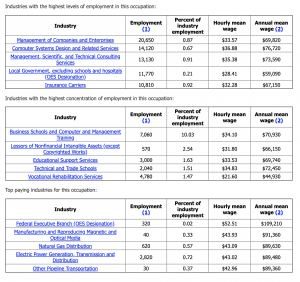
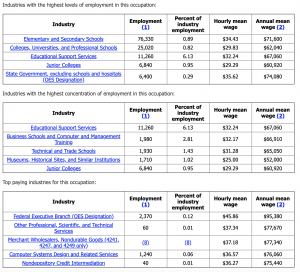
Skills in design and development, professional experience, communication and collaboration, and technical skills were consistent throughout the ID postings in each industry. Each sector also emphasized assessment, evaluation and project management skills in some capacity. Additionally, each sector highlighted knowledge and experience that was unique to the industry. For example, ID Training jobs emphasized knowledge of instructional frameworks such as the ADDIE model and experience with specific technologies such as Captivate and Storyline, whereas ID positions in K12 Education required more general technology skills (knowledge of a variety of operating systems, devices, and LMS), and classroom experience, in addition to having a teaching license. While skills such as teaching, training, coaching, mentoring, and facilitation were not consistent in all postings, they were emphasized in some capacity across all industries. The diversity of job titles across industries may signify trends in fields where ID is emerging. The words “Instructional” and “Designer” were ubiquitous, while words such as “Learning,” “Technologist,” “Specialist,” “Coach,” or “Trainer” ranged in frequency.
Chapter Limitations
We may have missed certain jobs related to ID because organizations aggregate job duties into the job titles. Some of these titles include: Digital Interactive Instructional Designer, Technical Instructional Designer/Copy Writer, Assistant Academic Designer, and Learning + Development Manager (Instructional Design). Other jobs choose to use synonyms for instruction and design in their jobs titles, presumably to stand out. For example, some ID jobs use Learning designer instead of Instructional designer or Developer instead of Designer. These tendencies were seen in the USA and abroad.
Regarding jobs abroad, certain countries could have specific ID job websites that would have proven more fruitful than American-based platforms like Indeed.com. Additionally, the language barrier undoubtedly limited the number of international jobs observed.
Additionally, we conducted our job search during a non-peak job-seeking time. The peak time starts around September, reaches a high point around November, and lasts until around February. Our project was conducted in March and April. Group members reported that the limited number of job postings caused us to be less selective about which positions to analyze.
Conclusion
After reviewing many job postings in the domain of instructional design, the following word cloud was created, which revealed the most commonly used words.
[Word Cloud using the text from 20 different ID job postings]

As shown in the previous sections, as well as the word cloud, all of the instructional designer roles have responsibilities of designing and developing learning experiences. Whether that experience is for K12 students, Higher Education students, or employees of a business differs depending on the field in which the instructional designer works. Some IDs may also be expected to have some content area knowledge, and knowledge of learning theories and emerging technologies is crucial. Professional development opportunities for instructional designers to learn and grow in their field may or may not be provided by the employer, so it is important to seek out learning opportunities in each of the realms detailed in this chapter.
Instructional design is not operationalized in the same way across job sectors. Depending on the company, there are different aspects valued of instructional design. For example, a job posting at Uber expected an entry-level instructional designer to have an “advanced knowledge” of learning analytics where it was often listed as a preferred qualification in other postings. Higher Education job-seekers need to focus on ADDIE and evaluating the impact of their ID materials and curriculum. ID positions in K12 Education are still emerging, but require individuals have technological, pedagogical, and content knowledge along with teaching experience and licensing. In many educational corporations, it is important to have a solid understanding of learning theories and instructional design principles, and a background in education (teaching or other educational roles) is helpful. Good time-management and communication skills are crucial, however IDs in this field are not expected to be project managers or coordinators.
As a final takeaway, Instructional Designers are needed in countries other than the USA. If a job-seeker wishes to pursue international positions, that person should have a strong grasp of the local culture while also retaining a global mindset (colloquially named “glocal”).
The overall instructional design domain is rapidly growing (US Bureau of Labor Statistics, 2018) and there is no shortage of jobs, as evidenced by the search conducted. For anyone wishing to start a new career or continue growth in this career, we urge you to consider the ATD model. Emphasize strengths, improve any weaknesses, and start searching for jobs under the titles given in this chapter.
References
Artisan Talent. (2016). Common instructional design principles. Retrieved from https://www.youtube.com/watch?v=mApAbA-eZto
ATD Competency Model. (2014). Retrieved from https://www.td.org/certification/atd-competency-model
Bean, C. (2014). The Accidental Instructional Designer: Learning Design for the Digital Age (1 edition). Alexandria, Va: Association for Talent Development.
Brown, & Green. (2015). Trends & Issues. Retrieved from http://trendsandissues.com/
Cheong, E., Wettasinghe, M. C., & Murphy, J. (2006). Professional Development of Instructional
Designers: A Proposed Framework Based on a Singapore Study. International Journal on ELearning, 5(2), 197–219.
Education Week. (n.d.). The Role for Instructional Designers in Developing the K12 Educational Environment. Retrieved from https://www.youtube.com/watch?v=bJCQkpc-Sfo
How different is instructional design in a K-12 setting vs. a corporate training setting? Retrieved March 20, 2019, from https://trainlikeachampion.blog/instructional-design-differences/
Instructional Coordinators : Occupational Outlook Handbook: : U.S. Bureau of Labor Statistics. (n.d.). Retrieved March 24, 2019, from https://www.bls.gov/ooh/education-training-and-library/instructional-coordinators.htm#tab-6 .
Instructional Design – K-12 | eLearning Innovation. (n.d.). Retrieved March 20, 2019, from https://elearninginnovation.com/instructional-design-k-12/
Instructional Designers Support K-12: Finding Their Niche In An Unexpected Place. (2018). Retrieved March 20, 2019, from https://elearningindustry.com/instructional-designers-support-k12-finding-niche-unexpected-place
Koszalka, T., Russ-Eft, D., Reiser, R (with Senior-Canela, F.Grabowski, B. & Wallington, C.J.) (2013) Instructional Design Competencies: The Standards (4th Ed). Information Age Publishing, Charlotte, NC.
Krippendorff, K. (2004). Reliability in content analysis. Human communication research, 30(3), 411-433.
Prometheus Training. (2015). What is instructional design? Retrieved from https://www.youtube.com/watch?v=uBs5qPzmPdg
Reiser, R. A. (2017). What field did you say you were in? In R. A. Reiser & J. V. Dempsey
(Eds.), Trends and issues in instructional design and technology (4th ed., pp. 1–7). New
York, NY: Pearson Education, Inc.
Richey, R. C., Fields, D. C., & Foxon, M. (2001). Instructional design competencies: The standards (3rd Ed.). ERIC Clearinghouse on Information & Technology, Syracuse University, Syracuse, NY.
Riley, G. (2014, July 21). Teacher vs. Instructional Designer. Retrieved March 24, 2019, from https://evolvingeducator.wordpress.com/2014/07/21/teacher-vs-instructional-designer/
So You Want to Be an Instructional Designer? – EdSurge News. (2016, March 29). Retrieved March 24, 2019, from https://www.edsurge.com/news/2016-03-29-so-you-want-to-be-an-instructional-designer
The eLearning Guild. (2019). eLearning salary & compensation: Advice for workers, recruiters, and hiring managers: Research library. Retrieved from https://www.elearningguild.com/insights/235/elearning-salary-compensation-advice-for-workers-recruiters-and-hiring-managers/
Training and Development: Occupational Outlook Handbook: U.S. Bureau of Labor Statistics. (2018). Retrieved March 20, 2019, from https://elearningindustry.com/instructional-designers-support-k12-finding-niche-unexpected-place
References to Job Postings
2019-2020 Instructional Technologist- Boyd Elementary job in Springfield, MO. (n.d.). Retrieved April 7, 2019, from SchoolSpring.com website: http://www.SchoolSpring.com/job.cfm?jid=3067622
Cengage. (2019). Learning Designer, https://careers-cengage.icims.com/jobs/6038/learning-designer/job
Curriculum Coach| K12JobSpot. (n.d.). Retrieved April 7, 2019, from https://jobseeker.teachers-teachers.com/opportunity/job/1240380
Indeed.com. (2019). e-Learning Specialist https://www.indeed.com/jobs?q=%E2%80%9Ceducational%20publishing%E2%80%9D%20AND%20%E2%80%9Cinstructional%20design%E2%80%9D&start=10&vjk=4d13beb1048c1732
Instructional Coach K-6 (#1447837) | K12JobSpot. (n.d.). Retrieved April 7, 2019, from https://www.k12jobspot.com/Job/1447837
Instructional Technology Coordinator job in Muskogee, OK. (n.d.). Retrieved April 7, 2019, from SchoolSpring.com website: http://www.SchoolSpring.com/job.cfm?jid=3071587
Instructional Technology Resource Teacher (ITRT) 2017-2018 (#324882) | K12JobSpot. (n.d.). Retrieved April 7, 2019, from https://www.k12jobspot.com/Job/324882
Instructional Technology Specialist job in Winchester, Massachusetts. (n.d.). Retrieved April 7, 2019, from SchoolSpring.com website: http://www.SchoolSpring.com/job.cfm?jid=3075182
Curriculum Associates. (2019). Interactive Designer. https://jobs.jobvite.com/curriculumassociates/job/oQFF9fw3
ITRT – Instructional Resource Technology Teacher (2019-2020 School Year) (#1400362) | K12JobSpot. (n.d.). Retrieved April 7, 2019, from https://www.k12jobspot.com/Job/1400362
JobID 673 : Instructional Technology Resource Teacher (ITRT) (#1378647) | K12JobSpot. (n.d.). Retrieved April 7, 2019, from https://www.k12jobspot.com/Job/1378647
JobID 1416 : Math Instructional Coach (#1445953) | K12JobSpot. (n.d.). Retrieved April 7, 2019, from https://www.k12jobspot.com/Job/1445953
JobID 2851 : Coordinator of Digital Learning (#1410270) | K12JobSpot. (n.d.). Retrieved April 7, 2019, from https://www.k12jobspot.com/Job/1410270
JobID 6675 : Instructional Coach, ELA (#1447740) | K12JobSpot. (n.d.). Retrieved April 7, 2019, from https://www.k12jobspot.com/Job/1447740
K12 hiring Instructional Designer, Level 3 – Herndon in Herndon, VA | LinkedIn. (n.d.). Retrieved April 7, 2019, from https://www.linkedin.com/jobs/view/instructional-designer-level-3-herndon-at-k12-1167355227
MassiveU hiring Instructional Designer – K12 and Professional Learning in Naples, FL | LinkedIn. (n.d.). Retrieved April 7, 2019, from https://www.linkedin.com/jobs/view/instructional-designer-k12-and-professional-learning-at-massiveu-1127553797
McGraw-Hill. (2019). Digital Interactive Designer (#1902385). https://careers.mheducation.com/ShowJob/Id/500674/Digital-Interactive-Designer/
Pearson. (2019). Instructional Designer, #1902385. (Job posting no longer available.)
Pearson. (2019). Learning Designer, #1901334. https://pearson.jobs/cape-town-zaf/learning-designer/5E4CF365565D4E15806D2B46528E4795/job/
Secondary Instructional Technology Specialist, English/Language Arts Experience Preferred (2019-2020) job in Houston, TX. (n.d.). Retrieved April 7, 2019, from SchoolSpring.com website: http://www.SchoolSpring.com/job.cfm?jid=3077213
Summit Academy Schools hiring Instructional Coordinator in Toledo, OH | LinkedIn. (n.d.). Retrieved April 7, 2019, from https://www.linkedin.com/jobs/view/instructional-coordinator-at-summit-academy-schools-1005615242
Technology Integration Coach (#1404559) | K12JobSpot. (n.d.). Retrieved April 7, 2019, from https://www.k12jobspot.com/Job/1404559